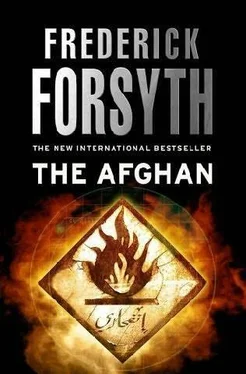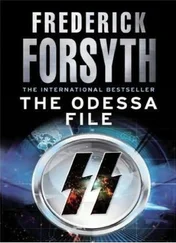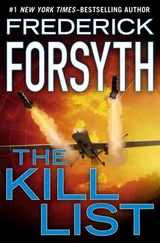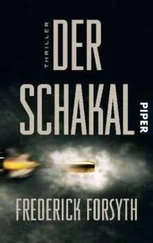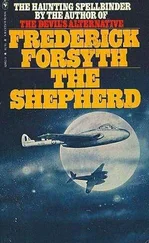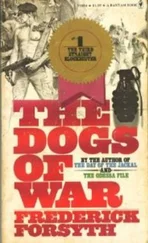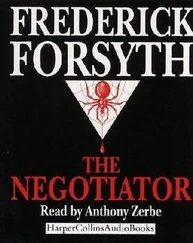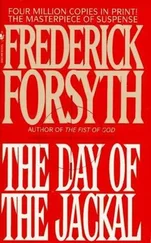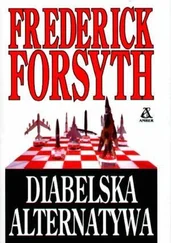When Mr. Wei had built the gallery masquerading as six sea containers along the deck of the Java Star from bridge to bow, he had created the roof, or “lid,” over the empty space beneath using a single sheet of steel held down by four strongpoints.
To these, the explosives man had fitted shaped charges, and linked all four to wires, taking power from the ship’s engines. When they blew, the sheet metal lid of the cavern beneath lifted upward several feet. The power of the charges was asymmetric, so one side of the sheet rose higher than the other. Martin was at the top of the rope ladder, knife clenched in teeth, when the charges blew. He crouched there as the huge sheet of steel slid sideways into the sea. He put the knife away, and entered the bridge. The Al Qaeda killer was standing at the wheel, staring ahead through the glass. On the horizon, bearing down at twenty-five knots, was a floating city, seventeen decks and 150,000 tons of lights, steel and people. Right beneath the bridge, the gallery was open to the stars. For the first time, Martin realized its purpose. Not to contain something; to hide something. The clouds moved away from the half-moon, and the entire fore-deck of the onetime Java Star gleamed in its light. For the first time, Martin realized this was not a general freighter containing explosives; it was a tanker. Running away from the bridge was the cat’s cradle of pipes, tubes, spigots and hydrant wheels that gave away her purpose in life.
Evenly spaced down the deck toward the forepeak were six circular steel disks-the venting hatches-above each of the cargo tanks beneath the deck. “You should have stayed on the boat, Afghan,” said Ibrahim. “There was no room, my brother. Suleiman almost fell overboard. I stayed on the ladder. Then they were gone. Now I will die here with you, inshallah.” Ibrahim seemed appeased. He glanced at the ship’s clock, and pulled his second lever. The flexes ran from the control down to the ship’s batteries, took their power and went forward into the gallery where the explosives man, entering through the secret door, had worked during his month at sea. Six more charges detonated. The six hatches blew away from above the tanks. What followed was invisible to the naked eye. Had it been possible to see, six vertical columns rose like volcanoes from the domes as the cargo began to vent. The rising vapor cloud reached a hundred feet, lost its impetus, and gravity took over. The unseen cloud, mixing furiously with the night air, fell back to the sea and began to roll outward, away from the source, in all directions. Martin had lost, and he knew it. He was too late, and he knew that, too. He knew enough to realize what a floating bomb he had been riding since the Philippines, and that what was pouring out of the six missing hatches was invisible death that could not now be controlled.
He had always presumed the Countess of Richmond, now become again the Java Star, was going to drive herself into some inner harbor and detonate what lay below her decks.
He had presumed she was going to ram something of value as she blew herself up. For thirty days, he had waited in vain for a chance to kill seven men and take over her command. No such chance had appeared.
Now, too late, he realized the Java Star was not going to deliver a bomb; she was the bomb. And with her cargo venting fast, she did not need to move an inch. The oncoming liner had to pass only within three kilometers of her to be consumed.
He had heard the interchange on the bridge between the Pakistani boy and the deck officer of the Queen Mary 2. He knew too late the Java Star would not engage engines. The escorting cruisers would never allow that, but she did not need to.
There was a third control by Ibrahim’s right hand, a button to be hammered downward. Martin followed the flexes to a Very pistol, a flare gun, mounted just forward of the bridge windows. One flare, one single spark… Through the windows, the city of lights was over the horizon. Fifteen miles, thirty minutes cruising, optimum time for maximum fuel-air mixture. Martin’s glance flicked to the radio speaker on the console. A last chance to shout a warning. His right hand slid down toward the slit in his robe, inside which was his knife strapped to his thigh.
The Jordanian caught the glance and the movement. He had not survived Afghanistan, a Jordanian jail and the relentless American hunt for him in Iraq without developing the instincts of a wild animal. Something told him that despite the fraternal language, the Afghan was not his friend. The raw hatred charged the atmosphere on the tiny bridge like a silent scream.
Martin’s hand slipped inside his robe for the knife. Ibrahim was first; the gun had been underneath the map on the chart table. It was pointing straight at Martin’s chest. The distance to cross was twelve feet. Ten too many. A soldier is trained to estimate chances, and do it fast. Martin had spent much of his life doing that. On the bridge of the Countess of Richmond, enveloped in her own death cloud, there were only two: go for the man, or go for the button. There would be no surviving either.
Some words came into his mind, words from long ago, in a schoolboy’s poem: “To every man upon this earth / Death cometh soon or late…” And he recalled Ahmad Shah Massoud, the Lion of the Panjshir, talking by the campfire. “We are all sentenced to die, Angleez. But only a warrior blessed of Allah may be allowed to choose how!” Colonel Mike Martin made his choice… Ibrahim saw him coming; he knew the flicker in the eyes of a man about to die. The killer screamed and fired. The charging man took the bullet in the chest, and began to die. But beyond pain and shock, there is always willpower, just enough for another second of life.
At the end of that second, both men and ship were consumed in a rose pink eternity.
***
David Gundlach stared in stunned amazement. Fifteen miles ahead, where the world’s largest liner would have been in thirty-five minutes, a huge volcano of flame erupted out of the sea. From the other three men on the night watch came cries of “What the hell was that?”
“ Monterey to Queen Mary 2. Divert to port. I say, divert to port. We are investigating.”
To his right, Gundlach saw the U.S. cruiser move up to attack speed and head for the flames. Even as he watched, they began to flicker and die upon the water. It was clear the Countess of Richmond had sustained some terrible accident. His job was to stay clear; if there were men in the water, the Monferey would find them. But it was still wise to summon his captain. When the ship’s master arrived on the bridge, his first officer explained what he had seen. They were now a full eighteen miles from the estimated spot, and heading away fast. To port, the USS Leyfe Gulf stayed with them. The Monferey was heading straight for the fireball miles up ahead. The captain agreed that in the unlikely event of survivors, the Monterey should search for them. As the two men watched from the safety of their bridge, the flames began to flicker and die. The last blotches of flame upon the sea would be the remnants of the vanished ship’s fuel oil. All the hy-pervolatile cargo was gone before the Monferey reached the spot.
The captain of the Cunarder ordered that the computers resume course for Southampton.
There was an inquiry. Of course. It took almost two years. These things are never done in a few hours, except on television. One team took the real Java Star, from the laying of her keel to the moment she steamed out of Brunei loaded with LPG, destination Fremantle, western Australia. It was confirmed by independent witnesses with no reason to lie that Captain Herrmann was in charge, and that all was well. She was seen by two other captains rounding the northeastern tip of Borneo Island shortly after that. Precisely because of her cargo, both ships’ masters noted she was well away from them, and logged her name.
Читать дальше
